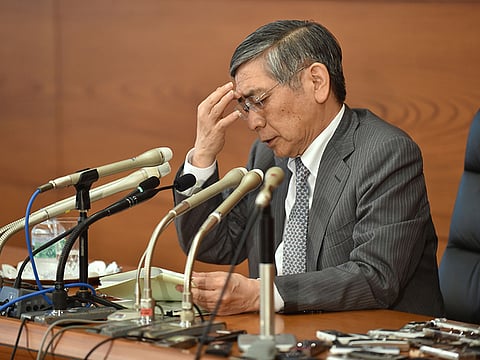Bank of Japan cuts economic growth, inflation outlook
Japan’s gross domestic product will expand 2.0% in the year to March 2016

Tokyo: The Bank of Japan cut its growth and inflation forecasts on Thursday, as a slate of tepid data highlight weakness in the world’s number three economy, while analysts expect more stimulus later this year.
Japan’s gross domestic product will expand 2.0 per cent in the year to March 2016, while the inflation rate is seen at 0.8 per cent, the BoJ said in a semi-annual report. That compares with a previous estimate of 2.1 per cent and 1.0 per cent respectively.
The BoJ report — which followed a meeting where policymakers held fire on fresh stimulus — appeared to push back an already murky timeline for hitting a 2.0 per cent inflation target to the first half of fiscal 2016, which runs from April through September next year.
The ambitious goal was originally supposed to have been achieved around two years after the launch of the BoJ’s stimulus in April 2013.
But the bank has, over time, loosened that timeline as the data suggested it was unattainable.
“It is true that the timing for achieving the 2.0 per cent inflation target has been delayed,” BoJ governor Haruhiko Kuroda told reporters Thursday.
“But price trends are improving steadily and that is expected to continue. We don’t see additional (easing) measures being necessary at this point.”
Kuroda has previously acknowledged that falling oil prices hurt efforts to drive up prices, and he warned over the possibility of zero inflation as the bid to drag Japan out of years of deflation proved to be “very challenging”.
‘Economic recovery stalling’
Economists have said the BoJ will ramp up its easing programme, likely later this year, to bring Japan closer to its elusive inflation target, which is a cornerstone of Prime Minister Shinzo Abe’s drive to conquer stagnant or falling prices and revive the economy.
“The bank obviously considers the slowdown in inflation since the autumn to be a temporary phenomenon, blaming it mostly on the plunge in energy prices. In our view there is more to it than that,” Marcel Thieliant at Capital Economics said in a commentary after the decision.
“The economic recovery is stalling, wages are barely rising, and inflation excluding food and energy is near zero, too. What’s more, it is far from clear that quantitative and qualitative easing has lifted inflation expectations among households and firms.”
In October, the bank shocked markets when it inflated its asset-buying stimulus plan by as much as 20 trillion yen annually, bringing it to the current level.
“The threat of persistent deflation will force policymakers to step up the pace of easing before long, perhaps as early as July,” Thieliant said.
Deflation may sound good for Japanese consumers, but it means people tend to put off buying because they do not expect prices to rise and hope they might even get goods cheaper down the line.
That, in turn, hurts producers and holds back their expansion and hiring plans, which is bad news for the economy.
Earlier Thursday, the BoJ in a widely expected decision stood pat on its record asset-purchase programme, which is adding about 80 trillion yen ($672 billion) to the money supply every year in a bid to jack up prices and kick-start growth.
One BoJ board member lost a call to shrink the stimulus programme by nearly half, with the rest of his eight colleagues voting to stay the course.
The yen got a boost, as the dollar slipped to 118.73 yen from 118.85 yen before the BoJ announcement. The pickup in the yen, bad news for Japanese exporters, helped send Tokyo’s benchmark Nikkei stock index tumbling 2.69 per cent Thursday.
Earlier in the morning official figures showed factory output fell by a less-than-expected 0.3 per cent in March — tepid figures that highlight an anaemic recovery.
Sign up for the Daily Briefing
Get the latest news and updates straight to your inbox
![Latest discovery follows several 1,000-tonne-plus gold finds in the past year. [Illustrative image]](http://media.assettype.com/gulfnews%2F2024-11-27%2F9rs31cwr%2FStock_Gold_Mining_18c61d0bfc2_original_ratio.jpg?w=320&auto=format%2Ccompress&fit=max)

